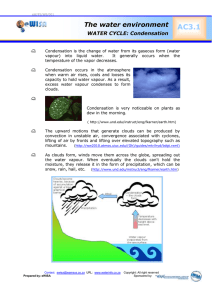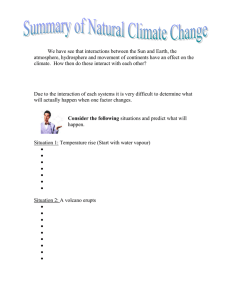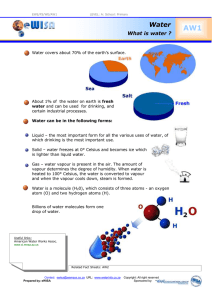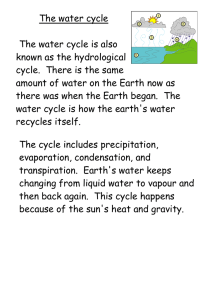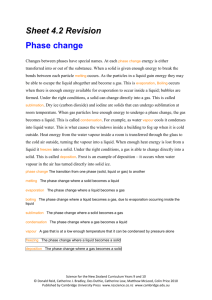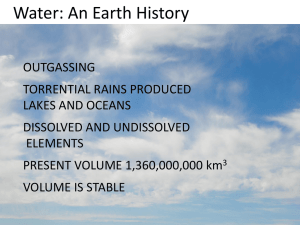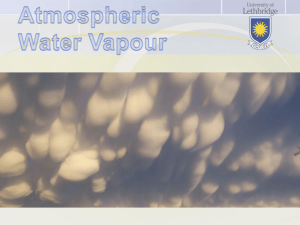CONDENSATION
advertisement
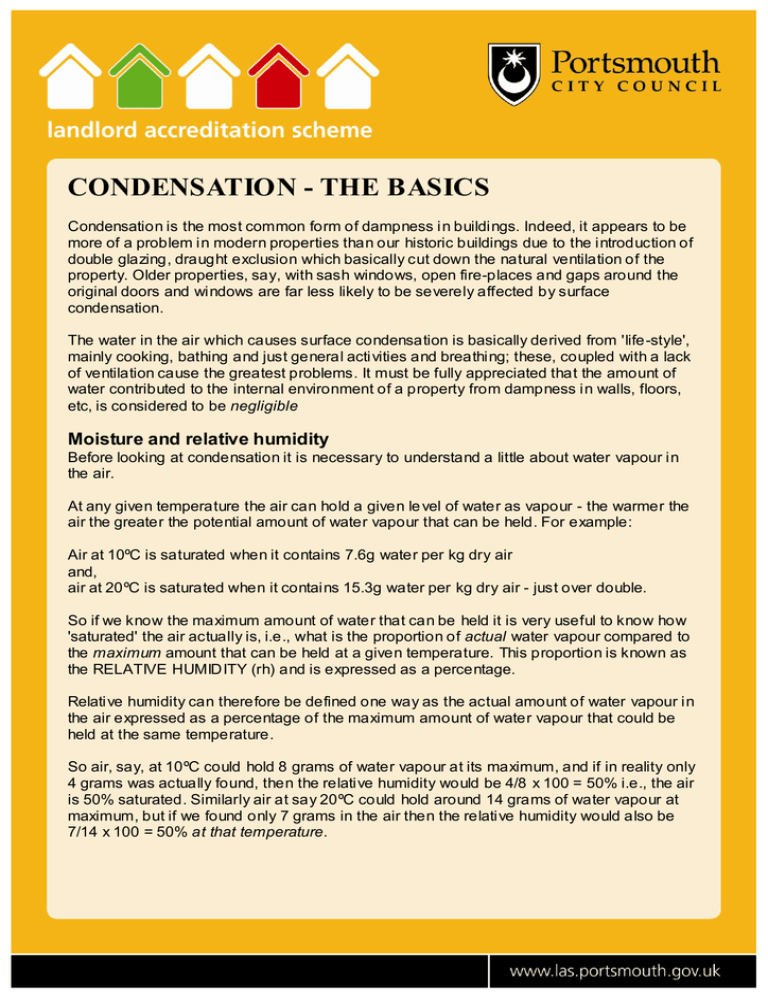
CONDENSATION - THE BASICS Condensation is the most common form of dampness in buildings. Indeed, it appears to be more of a problem in modern properties than our historic buildings due to the introduction of double glazing, draught exclusion which basically cut down the natural ventilation of the property. Older properties, say, with sash windows, open fire-places and gaps around the original doors and windows are far less likely to be severely affected by surface condensation. The water in the air which causes surface condensation is basically derived from 'life-style', mainly cooking, bathing and just general activities and breathing; these, coupled with a lack of ventilation cause the greatest problems. It must be fully appreciated that the amount of water contributed to the internal environment of a property from dampness in walls, floors, etc, is considered to be negligible Moisture and relative humidity Before looking at condensation it is necessary to understand a little about water vapour in the air. At any given temperature the air can hold a given le vel of water as vapour - the warmer the air the greater the potential amount of water vapour that can be held. For example: Air at 10ºC is saturated when it contains 7.6g water per kg dry air and, air at 20ºC is saturated when it contains 15.3g water per kg dry air - just over double. So if we know the maximum amount of water that can be held it is very useful to know how 'saturated' the air actually is, i.e., what is the proportion of actual water vapour compared to the maximum amount that can be held at a given temperature. This proportion is known as the RELATIVE HUMIDITY (rh) and is expressed as a percentage. Relative humidity can therefore be defined one way as the actual amount of water vapour in the air expressed as a percentage of the maximum amount of water vapour that could be held at the same temperature. So air, say, at 10ºC could hold 8 grams of water vapour at its maximum, and if in reality only 4 grams was actually found, then the relative humidity would be 4/8 x 100 = 50% i.e., the air is 50% saturated. Similarly air at say 20ºC could hold around 14 grams of water vapour at maximum, but if we found only 7 grams in the air then the relative humidity would also be 7/14 x 100 = 50% at that temperature. Condensation and dew point: What happens if we cool moisture at laden air? We know that cold air cannot hold as much water vapour as warm air, so as the temperature drops the relative humidity increases. The figure to the right illustrates why this is so Imagine the air as a 'bucket' holding a proportion of water. As the air is cooled the 'bucket' get smaller and therefore the proportion of water increases with decline in bucket size. If air is continued to be cooled, the 'bucket' will diminish to a size where it is now full with water, i.e., it is 100% full; if the air is cooled any further the 'bucket' will become even smaller and the water overflow. In reality this occurs where the air temperature has cooled so much that it can no longer hold the water as vapour. When this happens liquid water drops out of the air as CONDENSATION. The temperature at which condensation begins, i.e., when the relative humidity reaches 100% (air is fully saturated) is the DEW POINT temperature. Surface condensation The cause of surface condensation is where moisture laden air comes into contact with a suitably cold surface - any surface including walls, floors, sub-floor areas, roof spaces, etc As moisture-laden air gets close to the cold surface it starts to get cooled and so the relative humidity increases; the greater it is cooled the higher the relative humidity (remember water from a large bucket passing to a small bucket as explained above). Against the cold surface the temperature of the air now drops below the dew point temperature and liquid water drops out as condensation. Where does the water come from? Water comes from the 'life-style' - just normal everyday living (see table below). The amount of water produced from normal household activities can be quite considerable. Certain other activities such as using bottled gas and paraffin heaters add significant amounts of water to the air, the by-product of burning these fuels. Drying clothes over radiators will also significantly add water vapour. Also consider that the surface area of your lungs is in excess of 75 square metres and warm air is passing over this wet surface as we breathe 15-20 times per minute; this is being breathed back into the environment! Indeed, it is reported that a large dog can give off even more water vapour than the average adult! Water vapour source (average house/day) 4/5 people asleep: Approx water generated (in litres) 1.5 2 people active: 1.6 Cooking: 2.6 Washing up: 1.0 Washing clothes: 4.0 Drying clothes: Bathing/washing: 4.5 0.5 Approx. total 15.7 Contrary to popular belief, damp walls form rising/penetrating damp, and damp floors do not add significantly to the water burden in the air because water evaporation from such 'static' surfaces is very low compared to breathing and other active water producing activities. Indeed, recent figures obtained from Building Research Establishment using a validated model showed that a "saturated" floor slab of 8sq.m in a room at 60% rh and 20ºC lost around 36mls water per day, ie, 5 tea spoons full! This compares to around the 15 litres of so (nearly 4 gallons) produced from normal household activities. Indeed, and individual often produces 10 litres of water per day just form simple occupati onal activities. Furthermore, it becomes quite evident that given the rate of drying of a wall (1 month for every 25mm in thickness) then water is lost very slowly to the environment and even then most of the water passes outwards. Why? Water vapour exerts a pressure (it is part of the atmospheric pressure) and over most of the year there is more water vapour in a building that externally. In an unoccupied property external water vapour will balance with internal water vapour, but as soon as the building becomes occupied water vapour is generated internally and adds to the environmental water burden - the more water vapour, the greater the vapour pressure. This now means that there is a greater vapour pressure internally than external and so water vapour now passes down its vapour pressure gradient, ie, from inside to outside. Thus, the most likely direct cause of surface condensation is 'life-style', ie, water produced by the occupants activities, coupled with insufficient ventilation. Occasionally one can find a 'normal' life-style but certain areas of walls or cold spots (e.g., dense concrete lintels) are sufficient cold to allow condensate and mould growth to form. Mould growth Water vapour in the atmosphere alone causes no problems - certainly not health problems. Indeed, constant inhalation of very dry air can. However, condensation and maintenance of high humidities does lead to mould growth. This can usually be detected frequently by the musty odour associated with damp. Where such conditions occur it is mould spores in large numbers that may cause some to experience health problems. The most common mould associated with condensation is the 'black spot' mould, Aspergillus niger. However, other moulds may also develop - it depends on the substrate and conditions. For example, some moulds will readily colonise leather at relative humidities maintained around 76% whilst on brick and paint relative humidities in excess of 88% are reported required. Green and yellow moulds may be present; some white moulds are occasionally mistaken for efflorescent salts. It should be appreciated that some black moulds may be one of the 'toxic moulds', the most well know being Stachybotrys chartarum. This particular mould is black and slimy; it also requires a cellulose based substrate, i.e., paper and cardboard. So care may need to be taken when investigating the nature of mould growth. It is the mould growth that tends to cause the most concern because not only do they produce the musty odour but also cause decorative spoiling, and also spoiling of fabric in some cases. Moulds, once germinated, require the maintenance of persistently high relative humidities, usually over 75%, but frequently much higher. Moulds therefore have a tendency to develop in those areas where air flow is limited and the air remains damp and stagnant, e.g., corners, floor/wall junctions, etc, where we can frequently see 'triangular' patterns of moulds very typical of a condensation problem (photo above). Don't expect to maintain relative humidities less than 75% during periods the summer; moisture contents of the external air are such that relative humidities internally in excess of this will naturally occur. Beware of relative humidity figures alone without knowing the temperature! It can lead to misdiagnosis! For example in a recent case the air was reported to be at 65% relative humidity. The surface of the solid floor was pronounced to be 85% relative humidity from which it was stated that the floor was damp, possibly a damp-proof membrane defect. However, investigation showed the floor to be dry (no capillary moisture) and, as one would expect, several degrees cooler than the ambient air temperature. This would mean that the relative humidity at the floor surface was higher! Someone hadn't considered that the relative humidity increases as the temperature falls! And on the same principal, don't stick a relative humidity probe into a wall as a measurement of possible dampness - the wall is likely to be colder than the internal air temperature, and the coldness will increase the relative humidity with the same amount of water vapour in the air (NB the 'buckets' described above)-- the higher relative humidity obtained may not reflect 'dampness' in a wall, just the difference in temperature! You have been warned! Finally, on the use of electronic hygrometers. Some recent tests showed that for some electronic hygrometers to come into equilibrium with the surrounding environment took some considerable time. Thus, taking the instrument out of a cold car and using it immediately in a property would certainly give VERY misleading results. The instrument MUST be allowed to come up to room temperature (or down). Some initial tests suggests that as a rule of thumb you give a minimum of 10 minutes plus 3 minutes for each degree change in temperature. For example coming from a cold car, say 10ºC into a room at around 20ºC will take 10 + (10 x 3) = 40 minutes before one should contemplate recording data.
